Chinese spaceclaft rands on moon
- Thread starter spaminator
- Start date
You are using an out of date browser. It may not display this or other websites correctly.
You should upgrade or use an alternative browser.
You should upgrade or use an alternative browser.
Lunar New Year blessings from Mars as China releases footage from space probe
Author of the article:Reuters
Publishing date:
Feb 12, 2021 • 19 hours ago • 1 minute read

A view as Tianwen-1 probe enters the orbit of Mars in this screen grab obtained from a video on Feb. 12, 2021. PHOTO BY CHINA NATIONAL SPACE ADMINISTRATION (CNSA) /Handout via REUTERS
Article content
BEIJING — China’s space agency released two videos providing a close-up glimpse of Mars on Friday, captured as its Tianwen-1 probe entered the red planet’s orbit, saying the spacecraft was sending a Lunar New Year greeting to Earth.After a 6-1/2 month journey through space, the Tianwen-1 on Wednesday slowed to a speed at which it could be captured by the pull of Mars’ gravity and became the second spacecraft to reach the planet this month, with a U.S. probe set to arrive and immediately attempt a landing next week.
The two clips, lasting just under a minute, were the first released by the China National Space Administration of the probe entering orbit.
“The Tianwen-1’s New Year blessings came through from far-away Mars,” the CNSA said on Friday, the first day of the Lunar New Year.
The footage, shot from cameras attached to the uncrewed craft, shows it vibrating as its solar-powered thrusters are switched on to slow it down, with the spherical outline of Mars and even craters on the planet’s surface seen in the background as the probe hurtles past.
“The solar panels, directional antenna, Martian atmosphere and surface topography are clearly visible,” the CNSA said.

This handout photograph released on Feb. 5, 2021 by the China National Space Administration (CNSA) shows an image of Mars captured by China’s Mars probe Tianwen-1. PHOTO BY CHINA NATIONAL SPACE ADMINISTRAT /AFP via Getty Images
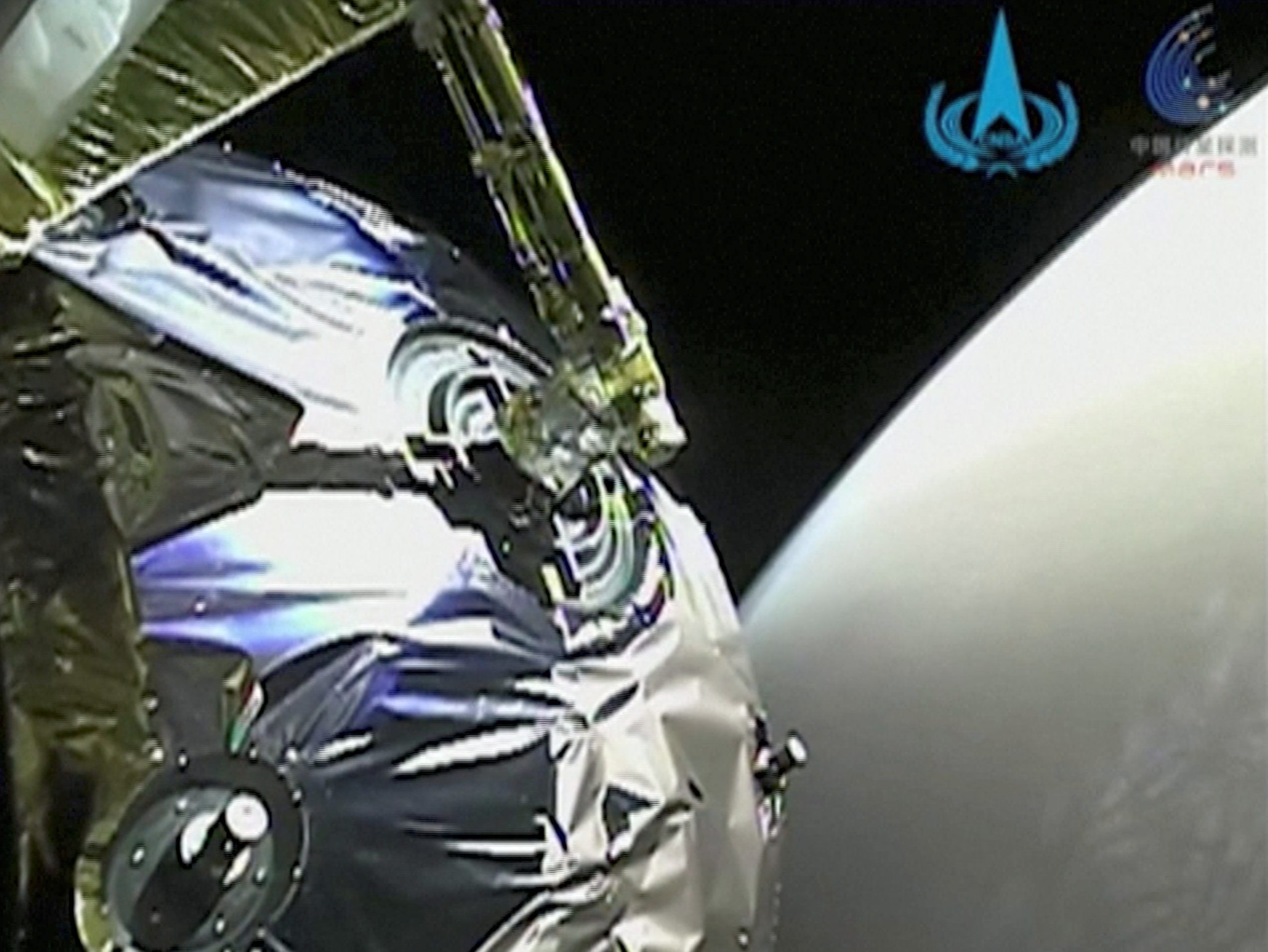
Lunar New Year blessings from Mars as China releases footage from space probe
BEIJING — China’s space agency released two videos providing a close-up glimpse of Mars on Friday, captured as its Tianwen-1 probe entered the red planet’s orbit, s…
China says rocket plunging back to Earth unlikely to cause harm
Author of the article:Reuters
Reuters
Publishing date:May 07, 2021 • 1 day ago • 1 minute read • 15 Comments
The Long March-5B Y2 rocket, carrying the core module of China's space station Tianhe, takes off from Wenchang Space Launch Center in Hainan province, China April 29, 2021.
The Long March-5B Y2 rocket, carrying the core module of China's space station Tianhe, takes off from Wenchang Space Launch Center in Hainan province, China April 29, 2021. PHOTO BY CHINA DAILY VIA REUTERS /China Daily via REUTERS
Article content
BEIJING — Most debris from a large Chinese rocket expected to plunge back through the atmosphere this weekend will be burned up on reentry and is highly unlikely to cause any harm, Chinese foreign ministry spokesman Wang Wenbin said on Friday.
The U.S. military said on Wednesday what it called an uncontrolled re-entry was being tracked by U.S. Space Command. The Long March 5B rocket blasted off from China’s Hainan island on April 29, carrying the unmanned Tianhe module, which contains what will become living quarters on a permanent Chinese space station.
The location of the rocket’s descent into Earth’s atmosphere as it falls back from space “cannot be pinpointed until within hours of its reentry,” which is projected to occur around May 8, U.S. Space Command said.
Harvard-based astrophysicist Jonathan McDowell told Reuters this week there was a chance that pieces of the rocket could come down over land such as in May 2020, when pieces from another Chinese Long March 5B rocket rained down on the Ivory Coast, damaging several buildings.
Advertisement
STORY CONTINUES BELOW
This advertisement has not loaded yet, but your article continues below.
Article content
He said potentially dangerous debris would likely escape incineration after streaking through the atmosphere at hypersonic speed but in all likelihood would fall into the sea, given that 70% of the world is covered by ocean.
Speaking in Beijing, Foreign Ministry spokesman Wang Wenbin said China was closely following the rocket’s reentry into the atmosphere, and that most of its components would be burned up upon re-entry.
“The probability of this process causing harm on the ground is extremely low,” he said.
Debris from the Long March 5B is likely to fall in international waters, China’s Global Times reported on Wednesday.
Based on its current orbit, the debris trail is likely to fall somewhere as far north as New York, Madrid or Beijing and as far south as southern Chile and Wellington, New Zealand, or anywhere in between, McDowell said.
The Tianhe launch was the first of 11 missions needed to complete the Chinese space station.
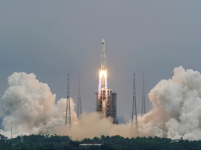
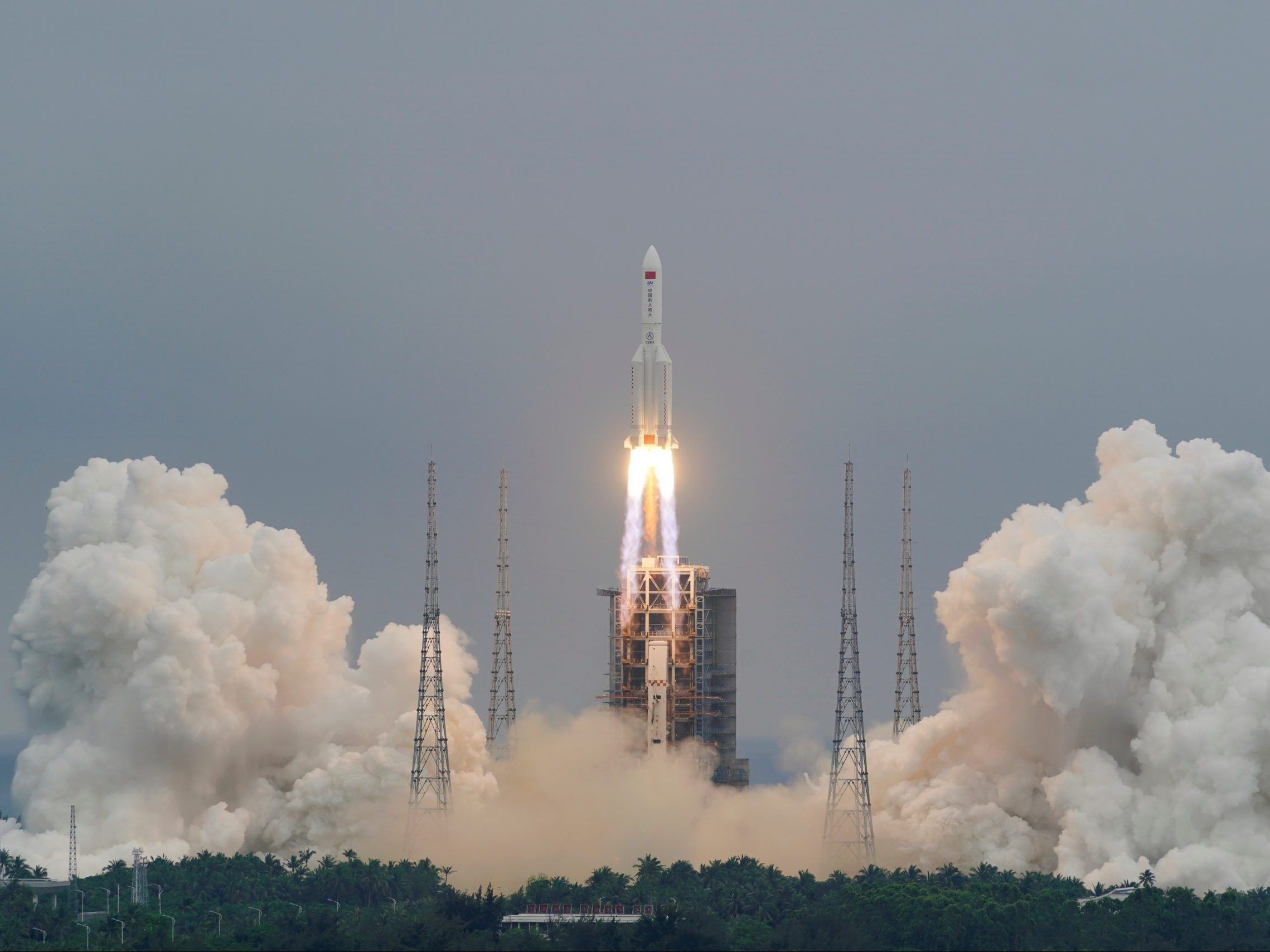
 torontosun.com
torontosun.com
Author of the article:Reuters
Reuters
Publishing date:May 07, 2021 • 1 day ago • 1 minute read • 15 Comments
The Long March-5B Y2 rocket, carrying the core module of China's space station Tianhe, takes off from Wenchang Space Launch Center in Hainan province, China April 29, 2021.
The Long March-5B Y2 rocket, carrying the core module of China's space station Tianhe, takes off from Wenchang Space Launch Center in Hainan province, China April 29, 2021. PHOTO BY CHINA DAILY VIA REUTERS /China Daily via REUTERS
Article content
BEIJING — Most debris from a large Chinese rocket expected to plunge back through the atmosphere this weekend will be burned up on reentry and is highly unlikely to cause any harm, Chinese foreign ministry spokesman Wang Wenbin said on Friday.
The U.S. military said on Wednesday what it called an uncontrolled re-entry was being tracked by U.S. Space Command. The Long March 5B rocket blasted off from China’s Hainan island on April 29, carrying the unmanned Tianhe module, which contains what will become living quarters on a permanent Chinese space station.
The location of the rocket’s descent into Earth’s atmosphere as it falls back from space “cannot be pinpointed until within hours of its reentry,” which is projected to occur around May 8, U.S. Space Command said.
Harvard-based astrophysicist Jonathan McDowell told Reuters this week there was a chance that pieces of the rocket could come down over land such as in May 2020, when pieces from another Chinese Long March 5B rocket rained down on the Ivory Coast, damaging several buildings.
Advertisement
STORY CONTINUES BELOW
This advertisement has not loaded yet, but your article continues below.
Article content
He said potentially dangerous debris would likely escape incineration after streaking through the atmosphere at hypersonic speed but in all likelihood would fall into the sea, given that 70% of the world is covered by ocean.
Speaking in Beijing, Foreign Ministry spokesman Wang Wenbin said China was closely following the rocket’s reentry into the atmosphere, and that most of its components would be burned up upon re-entry.
“The probability of this process causing harm on the ground is extremely low,” he said.
Debris from the Long March 5B is likely to fall in international waters, China’s Global Times reported on Wednesday.
Based on its current orbit, the debris trail is likely to fall somewhere as far north as New York, Madrid or Beijing and as far south as southern Chile and Wellington, New Zealand, or anywhere in between, McDowell said.
The Tianhe launch was the first of 11 missions needed to complete the Chinese space station.


China says rocket plunging back to Earth unlikely to cause harm
BEIJING — Most debris from a large Chinese rocket expected to plunge back through the atmosphere this weekend will be burned up on reentry and is highly unlikely to…
Chinese rocket debris set for uncontrolled re-entry by late Saturday
Author of the article:Reuters
Reuters
Publishing date:May 08, 2021 • 2 hours ago • 3 minute read • Join the conversation
This file photo taken on April 29, 2021 shows a Long March 5B rocket, carrying China's Tianhe space station core module, lifting off from the Wenchang Space Launch Center in southern China's Hainan province.
This file photo taken on April 29, 2021 shows a Long March 5B rocket, carrying China's Tianhe space station core module, lifting off from the Wenchang Space Launch Center in southern China's Hainan province. PHOTO BY STR /AFP via Getty Images
Article content
SHANGHAI — Remnants of China’s largest rocket launched last week are expected to plunge back through the atmosphere late Saturday or early Sunday, European and U.S. tracking centers said on Saturday.
China’s foreign ministry said on Friday that most debris from the rocket will burn on re-entry and is highly unlikely to cause any harm, after the U.S. military said that what it called an uncontrolled re-entry was being tracked by U.S. Space Command.
EU Space Surveillance and Tracking (EU SST) said its latest prediction for the timing of the re-entry of the Long March 5B rocket body was 139 minutes either side of 2:32 a.m. GMT on Sunday (10:32 p.m. EDT Saturday).
The U.S. Space Command on Saturday estimated re-entry would occur at 2:04 a.m. GMT on Sunday (10:04 p.m. EDT Saturday), plus or minus one hour, while the Center for Orbital Reentry and Debris Studies (CORDS) at Aerospace Corporation, a U.S. federally funded space-focused research and development center, updated its prediction to four hours either side of 3:30 a.m. GMT on Sunday (11:30 p.m. EDT Saturday).
Advertisement
STORY CONTINUES BELOW
This advertisement has not loaded yet, but your article continues below.
Article content
EU SST said on its website that the statistical probability of a ground impact in a populated area is “low,” but noted that the uncontrolled nature of the object made any predictions uncertain.
Space-Track, reporting data collected by U.S. Space Command, has estimated the debris will land in the North Atlantic Ocean, but said on Twitter on Saturday that reentry location estimates were largely uncertain until “just a handful of prior.”
The Long March 5B – comprising one core stage and four boosters – lifted off from China’s Hainan island on April 29 with the unmanned Tianhe module, which contains what will become living quarters on a permanent Chinese space station. The rocket is set to be followed by 10 more missions to complete the station.
Long March 5 rockets have been integral to China’s near-term space ambitions – from the delivery of modules and crew of its planned space station to launches of exploratory probes to the Moon and even Mars.
The Long March launched last week was the second deployment of the 5B variant since its maiden flight in May last year.
Harvard-based astrophysicist Jonathan McDowell previously told Reuters there is a chance that pieces of the rocket could come down over land, perhaps in a populated area, as in May 2020, when pieces from the first Long March 5B fell on Ivory Coast, damaging several buildings. No injuries were reported.
Debris from Chinese rocket launches is not uncommon within China. In late April, authorities in the city of Shiyan, Hubei Province, issued a notice to people in the surrounding county to prepare for evacuation as parts were expected to land in the area.
Advertisement
STORY CONTINUES BELOW
This advertisement has not loaded yet, but your article continues below.
Article content
“The Long March 5B reentry is unusual because during launch, the first stage of the rocket reached orbital velocity instead of falling down range as is common practice,” the Aerospace Corporation said in a blog post.
“The empty rocket body is now in an elliptical orbit around Earth where it is being dragged toward an uncontrolled re-entry.”
The empty core stage has been losing altitude since last week, but the speed of its orbital decay remains uncertain due to unpredictable atmospheric variables.
It is one of the largest pieces of space debris to return to Earth, with experts estimating its dry mass to be around 18 to 22 tonnes.
The core stage of the first Long March 5B that returned to Earth last year weighed nearly 20 tonnes, surpassed only by debris from the Columbia space shuttle in 2003, the Soviet Union’s Salyut 7 space station in 1991, and NASA’s Skylab in 1979.
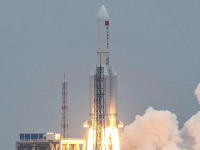
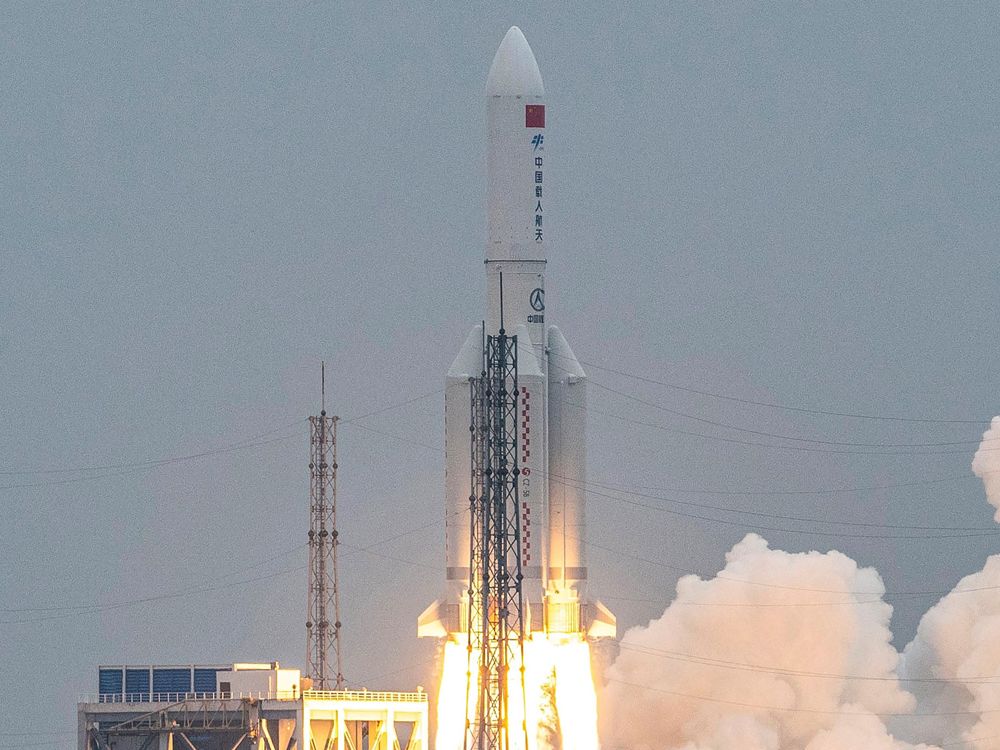
 torontosun.com
torontosun.com
Author of the article:Reuters
Reuters
Publishing date:May 08, 2021 • 2 hours ago • 3 minute read • Join the conversation
This file photo taken on April 29, 2021 shows a Long March 5B rocket, carrying China's Tianhe space station core module, lifting off from the Wenchang Space Launch Center in southern China's Hainan province.
This file photo taken on April 29, 2021 shows a Long March 5B rocket, carrying China's Tianhe space station core module, lifting off from the Wenchang Space Launch Center in southern China's Hainan province. PHOTO BY STR /AFP via Getty Images
Article content
SHANGHAI — Remnants of China’s largest rocket launched last week are expected to plunge back through the atmosphere late Saturday or early Sunday, European and U.S. tracking centers said on Saturday.
China’s foreign ministry said on Friday that most debris from the rocket will burn on re-entry and is highly unlikely to cause any harm, after the U.S. military said that what it called an uncontrolled re-entry was being tracked by U.S. Space Command.
EU Space Surveillance and Tracking (EU SST) said its latest prediction for the timing of the re-entry of the Long March 5B rocket body was 139 minutes either side of 2:32 a.m. GMT on Sunday (10:32 p.m. EDT Saturday).
The U.S. Space Command on Saturday estimated re-entry would occur at 2:04 a.m. GMT on Sunday (10:04 p.m. EDT Saturday), plus or minus one hour, while the Center for Orbital Reentry and Debris Studies (CORDS) at Aerospace Corporation, a U.S. federally funded space-focused research and development center, updated its prediction to four hours either side of 3:30 a.m. GMT on Sunday (11:30 p.m. EDT Saturday).
Advertisement
STORY CONTINUES BELOW
This advertisement has not loaded yet, but your article continues below.
Article content
EU SST said on its website that the statistical probability of a ground impact in a populated area is “low,” but noted that the uncontrolled nature of the object made any predictions uncertain.
Space-Track, reporting data collected by U.S. Space Command, has estimated the debris will land in the North Atlantic Ocean, but said on Twitter on Saturday that reentry location estimates were largely uncertain until “just a handful of prior.”
The Long March 5B – comprising one core stage and four boosters – lifted off from China’s Hainan island on April 29 with the unmanned Tianhe module, which contains what will become living quarters on a permanent Chinese space station. The rocket is set to be followed by 10 more missions to complete the station.
Long March 5 rockets have been integral to China’s near-term space ambitions – from the delivery of modules and crew of its planned space station to launches of exploratory probes to the Moon and even Mars.
The Long March launched last week was the second deployment of the 5B variant since its maiden flight in May last year.
Harvard-based astrophysicist Jonathan McDowell previously told Reuters there is a chance that pieces of the rocket could come down over land, perhaps in a populated area, as in May 2020, when pieces from the first Long March 5B fell on Ivory Coast, damaging several buildings. No injuries were reported.
Debris from Chinese rocket launches is not uncommon within China. In late April, authorities in the city of Shiyan, Hubei Province, issued a notice to people in the surrounding county to prepare for evacuation as parts were expected to land in the area.
Advertisement
STORY CONTINUES BELOW
This advertisement has not loaded yet, but your article continues below.
Article content
“The Long March 5B reentry is unusual because during launch, the first stage of the rocket reached orbital velocity instead of falling down range as is common practice,” the Aerospace Corporation said in a blog post.
“The empty rocket body is now in an elliptical orbit around Earth where it is being dragged toward an uncontrolled re-entry.”
The empty core stage has been losing altitude since last week, but the speed of its orbital decay remains uncertain due to unpredictable atmospheric variables.
It is one of the largest pieces of space debris to return to Earth, with experts estimating its dry mass to be around 18 to 22 tonnes.
The core stage of the first Long March 5B that returned to Earth last year weighed nearly 20 tonnes, surpassed only by debris from the Columbia space shuttle in 2003, the Soviet Union’s Salyut 7 space station in 1991, and NASA’s Skylab in 1979.


China says remnants of Long March rocket landed in Indian Ocean
BEIJING — Remnants of China’s biggest rocket landed in the Indian Ocean on Sunday, with most of its components destroyed upon re-entry into the atmosphere, ending d…
Horse shit, it's going to hit the White House and take out a Fake Government..
Horse shit, it's going to hit the White House and take out a Fake Government..

Breaking News on the BBC very soon:
"CHINESE ROCKET LANDS ON BIDEN'S HEAD."
China says remnants of Long March rocket landed in Indian Ocean
Author of the article:Reuters
Reuters
Publishing date:May 09, 2021 • 16 hours ago • 3 minute read • Join the conversation
This file photo taken on April 29, 2021 shows a Long March 5B rocket, carrying China's Tianhe space station core module, lifting off from the Wenchang Space Launch Center in southern China's Hainan province.
This file photo taken on April 29, 2021 shows a Long March 5B rocket, carrying China's Tianhe space station core module, lifting off from the Wenchang Space Launch Center in southern China's Hainan province. PHOTO BY STR /AFP via Getty Images
Article content
BEIJING — Remnants of China’s biggest rocket landed in the Indian Ocean on Sunday, with most of its components destroyed upon re-entry into the atmosphere, ending days of speculation over where the debris would hit but drawing U.S. criticism over lack of transparency.
The coordinates given by Chinese state media, citing the China Manned Space Engineering Office, put the point of impact in the ocean, west of the Maldives archipelago.
Debris from the Long March 5B has had some people looking warily skyward since it blasted off from China’s Hainan island on April 29, but the China Manned Space Engineering Office said most of the debris was burnt up in the atmosphere.
State media reported parts of the rocket re-entered the atmosphere at 10:24 a.m. Beijing time (0224 GMT) and landed at a location with the coordinates of longitude 72.47 degrees east and latitude 2.65 degrees north.
Advertisement
STORY CONTINUES BELOW
This advertisement has not loaded yet, but your article continues below.
Article content
The U.S. Space command confirmed the re-entry of the rocket over the Arabian Peninsula, but said it was unknown if the debris impacted land or water.
“The exact location of the impact and the span of debris, both of which are unknown at this time, will not be released by U.S. Space Command,” it said in a statement on its website.
The Long March was the second deployment of the 5B variant since its maiden flight in May 2020. Last year, pieces from the first Long March 5B fell on Ivory Coast, damaging several buildings. No injuries were reported.
“Spacefaring nations must minimize the risks to people and property on Earth of re-entries of space objects and maximize transparency regarding those operations,” NASA Administrator Bill Nelson, a former senator and astronaut who was picked for the role in March, said in a statement after the re-entry.
“It is clear that China is failing to meet responsible standards regarding their space debris.”
ANXIETY OVER POTENTIAL DEBRIS ZONE
With most of the Earth’s surface covered by water, the odds of populated area on land being hit had been low, and the likelihood of injuries even lower, according to experts.
But uncertainty over the rocket’s orbital decay and China’s failure to issue stronger reassurances in the run-up to the re-entry fueled anxiety.
“It is critical that China and all spacefaring nations and commercial entities act responsibly and transparently in space to ensure the safety, stability, security, and long-term sustainability of outer space activities,” Nelson said.
Advertisement
STORY CONTINUES BELOW
This advertisement has not loaded yet, but your article continues below.
Article content
Harvard-based astrophysicist Jonathan McDowell told Reuters that the potential debris zone could have been as far north as New York, Madrid or Beijing, and as far south as southern Chile and Wellington, New Zealand.
Since large chunks of the NASA space station Skylab fell from orbit in July 1979 and landed in Australia, most countries have sought to avoid such uncontrolled re-entries through their spacecraft design, McDowell said.
“It makes the Chinese rocket designers look lazy that they didn’t address this,” said McDowell.
The Global Times, a Chinese tabloid, dismissed as “Western hype” concerns the rocket was “out of control” and could cause damage.
“It is common practice across the world for upper stages of rockets to burn up while reentering the atmosphere,” Wang Wenbin, a spokesman at China’s foreign ministry, said at a regular media briefing on May 7.
“To my knowledge, the upper stage of this rocket has been deactivated, which means most of its parts will burn up upon re-entry, making the likelihood of damage to aviation or ground facilities and activities extremely low,” Wang said at the time.
The rocket, which put into orbit an unmanned Tianhe module containing what will become living quarters for three crew on a permanent Chinese space station, will be followed by 10 more missions to complete the station by 2022.
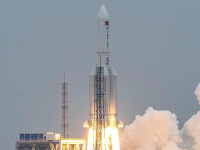

 torontosun.com
torontosun.com
Author of the article:Reuters
Reuters
Publishing date:May 09, 2021 • 16 hours ago • 3 minute read • Join the conversation
This file photo taken on April 29, 2021 shows a Long March 5B rocket, carrying China's Tianhe space station core module, lifting off from the Wenchang Space Launch Center in southern China's Hainan province.
This file photo taken on April 29, 2021 shows a Long March 5B rocket, carrying China's Tianhe space station core module, lifting off from the Wenchang Space Launch Center in southern China's Hainan province. PHOTO BY STR /AFP via Getty Images
Article content
BEIJING — Remnants of China’s biggest rocket landed in the Indian Ocean on Sunday, with most of its components destroyed upon re-entry into the atmosphere, ending days of speculation over where the debris would hit but drawing U.S. criticism over lack of transparency.
The coordinates given by Chinese state media, citing the China Manned Space Engineering Office, put the point of impact in the ocean, west of the Maldives archipelago.
Debris from the Long March 5B has had some people looking warily skyward since it blasted off from China’s Hainan island on April 29, but the China Manned Space Engineering Office said most of the debris was burnt up in the atmosphere.
State media reported parts of the rocket re-entered the atmosphere at 10:24 a.m. Beijing time (0224 GMT) and landed at a location with the coordinates of longitude 72.47 degrees east and latitude 2.65 degrees north.
Advertisement
STORY CONTINUES BELOW
This advertisement has not loaded yet, but your article continues below.
Article content
The U.S. Space command confirmed the re-entry of the rocket over the Arabian Peninsula, but said it was unknown if the debris impacted land or water.
“The exact location of the impact and the span of debris, both of which are unknown at this time, will not be released by U.S. Space Command,” it said in a statement on its website.
The Long March was the second deployment of the 5B variant since its maiden flight in May 2020. Last year, pieces from the first Long March 5B fell on Ivory Coast, damaging several buildings. No injuries were reported.
“Spacefaring nations must minimize the risks to people and property on Earth of re-entries of space objects and maximize transparency regarding those operations,” NASA Administrator Bill Nelson, a former senator and astronaut who was picked for the role in March, said in a statement after the re-entry.
“It is clear that China is failing to meet responsible standards regarding their space debris.”
ANXIETY OVER POTENTIAL DEBRIS ZONE
With most of the Earth’s surface covered by water, the odds of populated area on land being hit had been low, and the likelihood of injuries even lower, according to experts.
But uncertainty over the rocket’s orbital decay and China’s failure to issue stronger reassurances in the run-up to the re-entry fueled anxiety.
“It is critical that China and all spacefaring nations and commercial entities act responsibly and transparently in space to ensure the safety, stability, security, and long-term sustainability of outer space activities,” Nelson said.
Advertisement
STORY CONTINUES BELOW
This advertisement has not loaded yet, but your article continues below.
Article content
Harvard-based astrophysicist Jonathan McDowell told Reuters that the potential debris zone could have been as far north as New York, Madrid or Beijing, and as far south as southern Chile and Wellington, New Zealand.
Since large chunks of the NASA space station Skylab fell from orbit in July 1979 and landed in Australia, most countries have sought to avoid such uncontrolled re-entries through their spacecraft design, McDowell said.
“It makes the Chinese rocket designers look lazy that they didn’t address this,” said McDowell.
The Global Times, a Chinese tabloid, dismissed as “Western hype” concerns the rocket was “out of control” and could cause damage.
“It is common practice across the world for upper stages of rockets to burn up while reentering the atmosphere,” Wang Wenbin, a spokesman at China’s foreign ministry, said at a regular media briefing on May 7.
“To my knowledge, the upper stage of this rocket has been deactivated, which means most of its parts will burn up upon re-entry, making the likelihood of damage to aviation or ground facilities and activities extremely low,” Wang said at the time.
The rocket, which put into orbit an unmanned Tianhe module containing what will become living quarters for three crew on a permanent Chinese space station, will be followed by 10 more missions to complete the station by 2022.


China says remnants of Long March rocket landed in Indian Ocean
BEIJING — Remnants of China’s biggest rocket landed in the Indian Ocean on Sunday, with most of its components destroyed upon re-entry into the atmosphere, ending d…
China completes historic Mars spacecraft landing
Author of the article:Reuters
Reuters
Publishing date:May 14, 2021 • 11 hours ago • 2 minute read • 5 Comments
A view as Tianwen-1 probe enters the orbit of Mars in this screen grab obtained from a video on Feb. 12, 2021.
A view as Tianwen-1 probe enters the orbit of Mars in this screen grab obtained from a video on Feb. 12, 2021. PHOTO BY CHINA NATIONAL SPACE ADMINISTRATION (CNSA) /Handout via REUTERS
Article content
BEIJING — An uncrewed Chinese spacecraft successfully landed on the surface of Mars on Saturday, state news agency Xinhua reported, making China the second space-faring nation after the United States to land on the Red Planet.
The Tianwen-1 spacecraft landed on a site on a vast plain known as Utopia Planitia, “leaving a Chinese footprint on Mars for the first time,” Xinhua said.
Chinese President Xi Jinping issued a message of congratulations to all the people involved in the mission.
“You were brave enough for the challenge, pursued excellence and placed our country in the advanced ranks of planetary exploration,” he said. “Your outstanding achievement will forever be etched in the memories of the motherland and the people.”
The craft left its parked orbit at about 1700 GMT Friday (0100 Beijing time Saturday). The landing module separated from the orbiter three hours later and entered the Martian atmosphere, the official China Space News said.
Advertisement
STORY CONTINUES BELOW
This advertisement has not loaded yet, but your article continues below.
Article content
It said the landing process consisted of “nine minutes of terror” as the module decelerates and then slowly descends.
The official landing time was 2318 GMT (0718 Beijing time), Xinhua said, citing the China National Space Administration. The rover took more than 17 minutes to unfold its solar panels and antenna and send signals to ground controllers more than 320 million kilometers away.
The rover, named Zhurong, will now survey the landing site before departing from its platform to conduct inspections. Named after a mythical Chinese god of fire, Zhurong has six scientific instruments including a high-resolution topography camera.
It will study the planet’s surface soil and atmosphere. Zhurong will also look for signs of ancient life, including any sub-surface water and ice, using a ground-penetrating radar.
Tianwen-1, or “Questions to Heaven,” after a Chinese poem written two millennia ago, is China’s first independent mission to Mars. A probe co-launched with Russia in 2011 failed to leave the Earth’s orbit.
The five-tonne spacecraft blasted off from the southern Chinese island of Hainan in July last year, launched by the powerful Long March 5 rocket.
After more than six months in transit, Tianwen-1 reached the Red Planet in February where it had been in orbit since.
If Zhurong is successfully deployed, China would be the first country to orbit, land and release a rover in its maiden mission to Mars.
Tianwen-1 was one of three that reached Mars in February, with U.S. rover Perseverance successfully touching down on Feb. 18 in a huge depression called Jezero Crater, more than 2,000 km away from Utopia Planitia.
Advertisement
STORY CONTINUES BELOW
This advertisement has not loaded yet, but your article continues below.
Article content
Hope – the third spacecraft that arrived at Mars in February this year – is not designed to make a landing. Launched by the United Arab Emirates, it is currently orbiting above Mars gathering data on its weather and atmosphere.
The first successful landing ever was made by NASA’s Viking 1 in July 1976 and then by Viking 2 in September that year. A Mars probe launched by the former Soviet Union landed in December 1971, but communication was lost seconds after landing.
China is pursuing an ambitious space program. It is testing reusable spacecraft and is also planning to establish manned lunar research station.
In a commentary published on Saturday, Xinhua said China was “not looking to compete for leadership in space” but was committed to “unveiling the secrets of the universe and contributing to humanity’s peaceful use of space.”


 torontosun.com
torontosun.com
Author of the article:Reuters
Reuters
Publishing date:May 14, 2021 • 11 hours ago • 2 minute read • 5 Comments
A view as Tianwen-1 probe enters the orbit of Mars in this screen grab obtained from a video on Feb. 12, 2021.
A view as Tianwen-1 probe enters the orbit of Mars in this screen grab obtained from a video on Feb. 12, 2021. PHOTO BY CHINA NATIONAL SPACE ADMINISTRATION (CNSA) /Handout via REUTERS
Article content
BEIJING — An uncrewed Chinese spacecraft successfully landed on the surface of Mars on Saturday, state news agency Xinhua reported, making China the second space-faring nation after the United States to land on the Red Planet.
The Tianwen-1 spacecraft landed on a site on a vast plain known as Utopia Planitia, “leaving a Chinese footprint on Mars for the first time,” Xinhua said.
Chinese President Xi Jinping issued a message of congratulations to all the people involved in the mission.
“You were brave enough for the challenge, pursued excellence and placed our country in the advanced ranks of planetary exploration,” he said. “Your outstanding achievement will forever be etched in the memories of the motherland and the people.”
The craft left its parked orbit at about 1700 GMT Friday (0100 Beijing time Saturday). The landing module separated from the orbiter three hours later and entered the Martian atmosphere, the official China Space News said.
Advertisement
STORY CONTINUES BELOW
This advertisement has not loaded yet, but your article continues below.
Article content
It said the landing process consisted of “nine minutes of terror” as the module decelerates and then slowly descends.
The official landing time was 2318 GMT (0718 Beijing time), Xinhua said, citing the China National Space Administration. The rover took more than 17 minutes to unfold its solar panels and antenna and send signals to ground controllers more than 320 million kilometers away.
The rover, named Zhurong, will now survey the landing site before departing from its platform to conduct inspections. Named after a mythical Chinese god of fire, Zhurong has six scientific instruments including a high-resolution topography camera.
It will study the planet’s surface soil and atmosphere. Zhurong will also look for signs of ancient life, including any sub-surface water and ice, using a ground-penetrating radar.
Tianwen-1, or “Questions to Heaven,” after a Chinese poem written two millennia ago, is China’s first independent mission to Mars. A probe co-launched with Russia in 2011 failed to leave the Earth’s orbit.
The five-tonne spacecraft blasted off from the southern Chinese island of Hainan in July last year, launched by the powerful Long March 5 rocket.
After more than six months in transit, Tianwen-1 reached the Red Planet in February where it had been in orbit since.
If Zhurong is successfully deployed, China would be the first country to orbit, land and release a rover in its maiden mission to Mars.
Tianwen-1 was one of three that reached Mars in February, with U.S. rover Perseverance successfully touching down on Feb. 18 in a huge depression called Jezero Crater, more than 2,000 km away from Utopia Planitia.
Advertisement
STORY CONTINUES BELOW
This advertisement has not loaded yet, but your article continues below.
Article content
Hope – the third spacecraft that arrived at Mars in February this year – is not designed to make a landing. Launched by the United Arab Emirates, it is currently orbiting above Mars gathering data on its weather and atmosphere.
The first successful landing ever was made by NASA’s Viking 1 in July 1976 and then by Viking 2 in September that year. A Mars probe launched by the former Soviet Union landed in December 1971, but communication was lost seconds after landing.
China is pursuing an ambitious space program. It is testing reusable spacecraft and is also planning to establish manned lunar research station.
In a commentary published on Saturday, Xinhua said China was “not looking to compete for leadership in space” but was committed to “unveiling the secrets of the universe and contributing to humanity’s peaceful use of space.”


China completes historic Mars spacecraft landing
BEIJING — An uncrewed Chinese spacecraft successfully landed on the surface of Mars on Saturday, state news agency Xinhua reported, making China the second space-fa…
Space junk poised for high-speed crash into moon
Author of the article ostmedia News
ostmedia News
Publishing date:Mar 02, 2022 • 14 hours ago • 1 minute read • Join the conversation
A leftover rocket will crash into the far side of the moon at 9,300 km/h on Friday, away from telescopes, according to The Associated Press.
A leftover rocket will crash into the far side of the moon at 9,300 km/h on Friday, away from telescopes, according to The Associated Press. PHOTO BY ISTOCK /GETTY IMAGES
Article content
There could soon be a whole lotta space junk in the moon’s trunk.
Advertisement
STORY CONTINUES BELOW
Article content
More than 2.7 tonnes of it, in fact.
A leftover rocket will crash into the far side of the moon at 9,300 km/h on Friday, away from telescopes, according to the Associated Press.
The impact will be discovered via satellite images and could take weeks or months to confirm.
Since being launched by China nearly a decade ago, the rocket junk has been tumbling through space. Chinese officials are being hesitant to claim it as their space debris.
Scientists say the object is likely to carve out a hole 10 metres to 20 metres across the moon and send dust flying hundreds of kilometres across the barren surface.
While low-orbiting space junk is fairly easy to track, objects launching deeper into space aren’t likely to hit anything and are often generally overlooked.
Elon Musk’s SpaceX initially took responsibility for the moon garbage, but asteroid tracker Bill Gray later said the junk was not from a SpaceX Falcon rocket launched in 2015, as originally thought.
Rather, the space expert said, it was likely the third stage of a Chinese rocket that sent a test sample capsule to the moon and back in 2014.
The U.S. Space Command, which tracks space junk, said Tuesday the Chinese upper stage from 2014 never left orbit as previously indicated in its database.
It could mean more craters for the moon, which is ultimately defenceless.
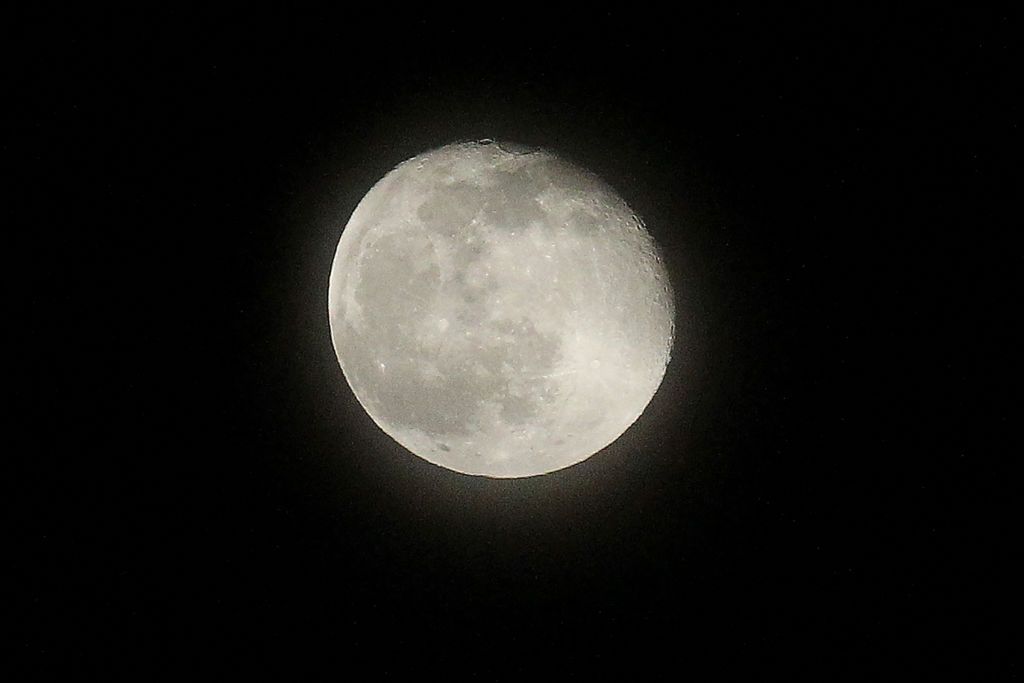
 torontosun.com
torontosun.com
Author of the article
Publishing date:Mar 02, 2022 • 14 hours ago • 1 minute read • Join the conversation
A leftover rocket will crash into the far side of the moon at 9,300 km/h on Friday, away from telescopes, according to The Associated Press.
A leftover rocket will crash into the far side of the moon at 9,300 km/h on Friday, away from telescopes, according to The Associated Press. PHOTO BY ISTOCK /GETTY IMAGES
Article content
There could soon be a whole lotta space junk in the moon’s trunk.
Advertisement
STORY CONTINUES BELOW
Article content
More than 2.7 tonnes of it, in fact.
A leftover rocket will crash into the far side of the moon at 9,300 km/h on Friday, away from telescopes, according to the Associated Press.
The impact will be discovered via satellite images and could take weeks or months to confirm.
Since being launched by China nearly a decade ago, the rocket junk has been tumbling through space. Chinese officials are being hesitant to claim it as their space debris.
Scientists say the object is likely to carve out a hole 10 metres to 20 metres across the moon and send dust flying hundreds of kilometres across the barren surface.
While low-orbiting space junk is fairly easy to track, objects launching deeper into space aren’t likely to hit anything and are often generally overlooked.
Elon Musk’s SpaceX initially took responsibility for the moon garbage, but asteroid tracker Bill Gray later said the junk was not from a SpaceX Falcon rocket launched in 2015, as originally thought.
Rather, the space expert said, it was likely the third stage of a Chinese rocket that sent a test sample capsule to the moon and back in 2014.
The U.S. Space Command, which tracks space junk, said Tuesday the Chinese upper stage from 2014 never left orbit as previously indicated in its database.
It could mean more craters for the moon, which is ultimately defenceless.

Space junk poised for high-speed crash into moon
There could soon be a whole lotta space junk in the moon's trunk.
Plicks!The least they could do is crash it on the near side so we can get some good video.
China rejects NASA accusation it will take over the moon
U.S. space agency chief said China's space program was military one and that China had stolen ideas and technology from others
Author of the article:Reuters
Reuters
Publishing date:Jul 04, 2022 • 19 hours ago • 1 minute read • 5 Comments
BEIJING — China on Monday rejected as an irresponsible smear a warning from the chief of NASA that China might “take over” the moon as part of a military program, saying it has always called for the building of a community of nations in outer space.
China has stepped up the pace of its space program in the past decade, with exploration of the moon a focus. China made its first lunar uncrewed landing in 2013 and expects to launch rockets powerful enough to send astronauts to the moon towards the end of this decade.
“We must be very concerned that China is landing on the moon and saying: ‘It’s ours now and you stay out’,” NASA Administrator Bill Nelson told German newspaper Bild in an interview published on Saturday.
The U.S. space agency chief said China’s space program was a military one and that China had stolen ideas and technology from others.
“This is not the first time that the head of the U.S. National Aeronautics and Space Administration has ignored the facts and spoken irresponsibly about China,” said Zhao Lijian, a spokesman at the Chinese foreign ministry.
“The U.S. side has constantly constructed a smear campaign against China’s normal and reasonable outer space endeavors, and China firmly opposes such irresponsible remarks.”
China has always promoted the building of a shared future for humanity in outer space and opposed its weaponization and any arms race in space, he said.
NASA, under its Artemis program, plans to send a crewed mission to orbit the moon in 2024 and make a crewed landing near the lunar south pole by 2025.
China is planning uncrewed missions to the moon’s south pole some time this decade.

 torontosun.com
torontosun.com
U.S. space agency chief said China's space program was military one and that China had stolen ideas and technology from others
Author of the article:Reuters
Reuters
Publishing date:Jul 04, 2022 • 19 hours ago • 1 minute read • 5 Comments
BEIJING — China on Monday rejected as an irresponsible smear a warning from the chief of NASA that China might “take over” the moon as part of a military program, saying it has always called for the building of a community of nations in outer space.
China has stepped up the pace of its space program in the past decade, with exploration of the moon a focus. China made its first lunar uncrewed landing in 2013 and expects to launch rockets powerful enough to send astronauts to the moon towards the end of this decade.
“We must be very concerned that China is landing on the moon and saying: ‘It’s ours now and you stay out’,” NASA Administrator Bill Nelson told German newspaper Bild in an interview published on Saturday.
The U.S. space agency chief said China’s space program was a military one and that China had stolen ideas and technology from others.
“This is not the first time that the head of the U.S. National Aeronautics and Space Administration has ignored the facts and spoken irresponsibly about China,” said Zhao Lijian, a spokesman at the Chinese foreign ministry.
“The U.S. side has constantly constructed a smear campaign against China’s normal and reasonable outer space endeavors, and China firmly opposes such irresponsible remarks.”
China has always promoted the building of a shared future for humanity in outer space and opposed its weaponization and any arms race in space, he said.
NASA, under its Artemis program, plans to send a crewed mission to orbit the moon in 2024 and make a crewed landing near the lunar south pole by 2025.
China is planning uncrewed missions to the moon’s south pole some time this decade.

China rejects NASA accusation it will take over the moon
China on Monday rejected as an irresponsible smear a warning from the chief of NASA that China might "take over" the moon.
China plans to build nuclear-powered moon base within six years
Author of the article:Bloomberg News
Bloomberg News
Selina Xu
Publishing date:Nov 25, 2022 • 1 day ago • 1 minute read
A model of the Long March-5 Y5 rocket from China's lunar exploration program Chang'e-5 Mission is displayed at an exhibition inside the National Museum in Beijing, March 3, 2021.
A model of the Long March-5 Y5 rocket from China's lunar exploration program Chang'e-5 Mission is displayed at an exhibition inside the National Museum in Beijing, March 3, 2021. PHOTO BY TINGSHU WANG/FILE PHOTO /REUTERS
China plans to build its first base on the moon by 2028, ahead of landing astronauts there in subsequent years as the country steps up its challenge to NASA’s dominance in space exploration.
The lunar base will likely be powered by nuclear energy, Caixin reported. Its basic configuration will consist of a lander, hopper, orbiter and rover, all of which would be constructed by the Chang’e 6, 7 and 8 missions.
“Our astronauts will likely be able to go to the moon within 10 years,” Wu Weiran, chief designer of China’s lunar exploration program, said in an interview with state broadcaster CCTV earlier this week. Nuclear energy can address the lunar station’s long-term, high-power energy needs, he said.
China has ramped up its ambitions in space in recent years, sending probes to the moon, building its own space station and setting its sights on Mars. The plans have put it in direct competition with the U.S. NASA has a rover on the Red Planet and is seeking to return astronauts to the moon this decade for the first time since the Apollo program ended in the 1970s.
Both China and the U.S. are spending billions of dollars to not just put humans on the moon, but also to access resources that could foster life on the lunar surface or send spacecraft to Mars.
In 2019, China became the first country to land a rover on the far side of the moon, and later brought back its first lunar samples. The base is intended to be the first outpost on the moon’s South Pole, an area scientists think is the best place to find water. NASA is also targeting that part of the moon. China aims to eventually expand the base into an international research station.
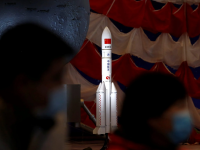
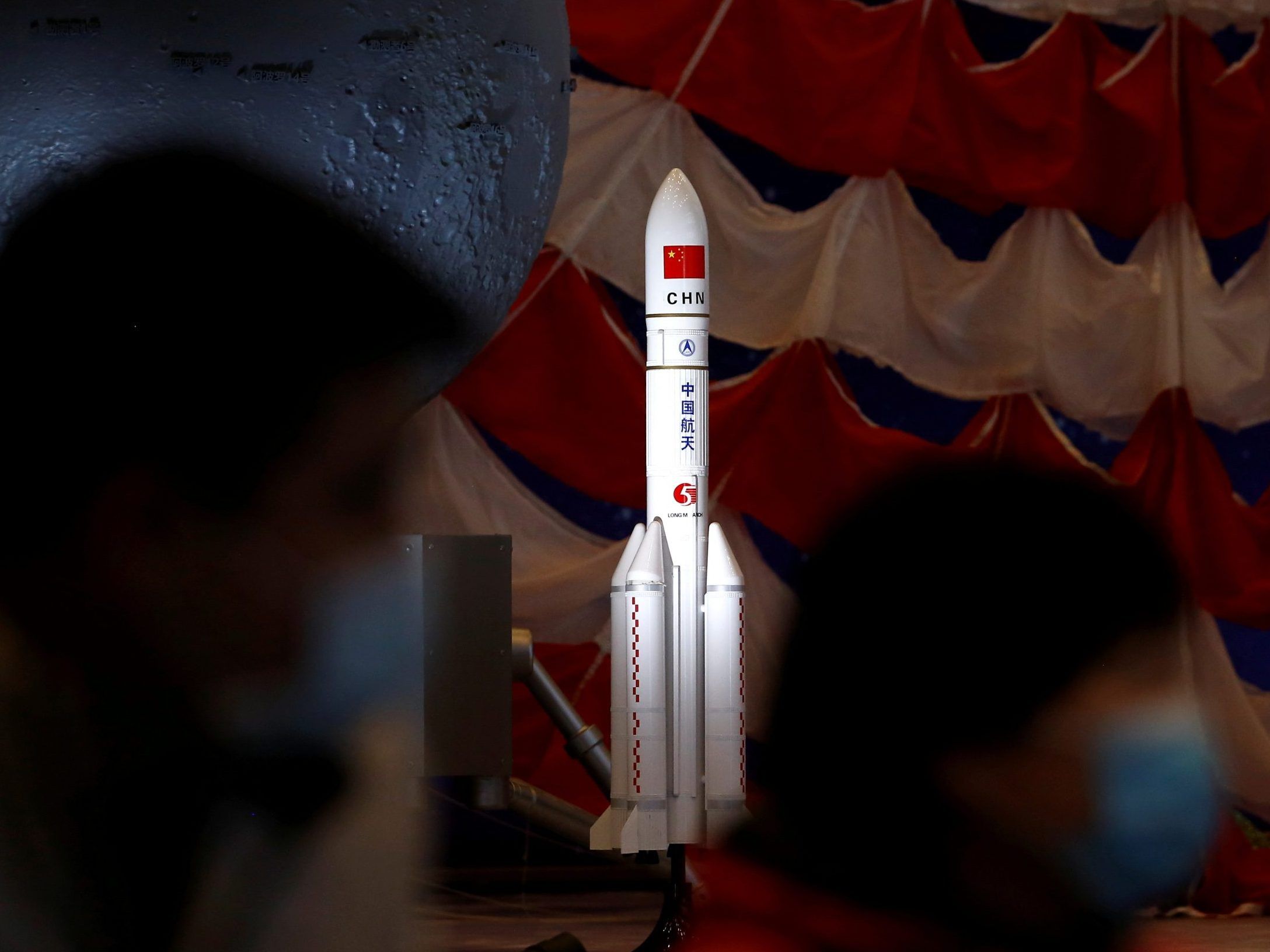
 torontosun.com
torontosun.com
Author of the article:Bloomberg News
Bloomberg News
Selina Xu
Publishing date:Nov 25, 2022 • 1 day ago • 1 minute read
A model of the Long March-5 Y5 rocket from China's lunar exploration program Chang'e-5 Mission is displayed at an exhibition inside the National Museum in Beijing, March 3, 2021.
A model of the Long March-5 Y5 rocket from China's lunar exploration program Chang'e-5 Mission is displayed at an exhibition inside the National Museum in Beijing, March 3, 2021. PHOTO BY TINGSHU WANG/FILE PHOTO /REUTERS
China plans to build its first base on the moon by 2028, ahead of landing astronauts there in subsequent years as the country steps up its challenge to NASA’s dominance in space exploration.
The lunar base will likely be powered by nuclear energy, Caixin reported. Its basic configuration will consist of a lander, hopper, orbiter and rover, all of which would be constructed by the Chang’e 6, 7 and 8 missions.
“Our astronauts will likely be able to go to the moon within 10 years,” Wu Weiran, chief designer of China’s lunar exploration program, said in an interview with state broadcaster CCTV earlier this week. Nuclear energy can address the lunar station’s long-term, high-power energy needs, he said.
China has ramped up its ambitions in space in recent years, sending probes to the moon, building its own space station and setting its sights on Mars. The plans have put it in direct competition with the U.S. NASA has a rover on the Red Planet and is seeking to return astronauts to the moon this decade for the first time since the Apollo program ended in the 1970s.
Both China and the U.S. are spending billions of dollars to not just put humans on the moon, but also to access resources that could foster life on the lunar surface or send spacecraft to Mars.
In 2019, China became the first country to land a rover on the far side of the moon, and later brought back its first lunar samples. The base is intended to be the first outpost on the moon’s South Pole, an area scientists think is the best place to find water. NASA is also targeting that part of the moon. China aims to eventually expand the base into an international research station.


China plans to build nuclear-powered moon base within six years
China plans to build its first base on the moon by 2028, ahead of landing astronauts there in subsequent years.


